- Home
- Ian Buruma
Inventing Japan: 1853-1964 (Modern Library Chronicles) Page 8
Inventing Japan: 1853-1964 (Modern Library Chronicles) Read online
Page 8
Hayashi was echoing propaganda of the 1930s, which always painted Japan as the victim of Western powers, whose wicked bullying forced Japan to stand up for the Asian people. One of the chief architects of Japan’s war on China told his interrogators after 1945 that Commodore Perry and his black ships were really to blame for the whole thing, because Perry had dragged Japan from peaceful isolation into the merciless international system of big-power rivalry. It is a thesis one still comes across in the more reactionary Japanese journals. Since these journals get more attention now than more liberal publications, it would be wise to take note of such views. But whatever one wishes to call the war, there is no doubt that 1931 marked a new beginning of Japanese military aggression on the Asian continent.
The Manchurian incident occurred on September 18, 1931. It could easily have happened earlier. Although a Chinese warlord governed Manchuria as a semi-independent fiefdom, the Japanese were already in a strong position. The Japanese Kwantung army controlled the area along the South Manchurian Railway, which included most of the main cities, such as Harbin and Mukden. The port cities of Dalian and Port Arthur were already under direct Japanese administration. But the army was getting restless and wanted more. The worldwide economic slump was hitting Japan hard, and a violently anticapitalist mood was taking hold of some of the younger officers and men. In Tokyo, right-wing zealots and junior officers were agitating against businessmen and civilian politicians and plotting coups d’états. In China, Chiang Kai-shek’s army was moving north in an attempt to unify the nation under a nationalist government. The Chinese saw Manchuria as part of China; the Japanese, despite earlier treaties to that effect, did not. They preferred to see it as a kind of lawless no-man’s-land, to which Japan would bring order. Since Manchuria had been part of the last Chinese empire, which lasted for almost three centuries, the Chinese had a legitimate claim. The fact that large parts of China were lawless did not give Japan the right to take them over.
Manchuria in the 1930s was full of bellicose Japanese officers, right-wing dreamers, and revolutionary desperadoes. Lieutenant Colonel Ishiwara Kanji was all of these things. A brilliant baby-faced maverick, he had studied for three years in Germany, where he picked up modish ideas on global racial war. The endgame, in his view, was a titanic struggle between the white and yellow races, with Japan and America as the main adversaries. Like Kita Ikki, the intellectual mentor of military extremists, he was a disciple of Nichiren Buddhism and dreamed of the whole world united under one Japanese imperial roof. But first he plotted a Japanese army takeover of Manchuria, which in due course would be transformed into “paradise.”
An earlier plot had failed in 1928, when Kwantung army men blew up the local warlord Chang Tso-lin’s train. Blaming it on Chinese soldiers, they had hoped to create an excuse for the Japanese army to take control. It didn’t quite come off. Emperor Hirohito, appalled by such disorderly conduct, forced his prime minister to resign, and the affair was effectively hushed up. So this time, in 1931, things would have to be organized better. On the night of September 18, a bomb was set off by Japanese soldiers next to the railway line near Mukden. No real harm was done to South Manchurian Railway property, the trains still ran on time, but it provided the cue for an attack on Chinese troops in Mukden, who were blamed for the “sabotage.” In an attempt to calm things down, Chang Hsüeh-liang, who succeeded his father as warlord, told his men not to resist. The Japanese then announced that all Chinese soldiers were bandits, and all bandits Chinese soldiers, and since it was the duty of the Kwantung army to ensure the safety and security of Manchuria, they attacked them anyway. Within six months, much of Manchuria was in Japanese hands. The Chinese complained to the League of Nations. And the Japanese duly cranked out propaganda at home about Japan being victimized by the rest of the world.
The prime minister at the time of the Manchurian incident, Wakatsuji Reijiro, was still a party politician who favored a conciliatory policy toward China. He was in a state of panic. The Kwantung army was pushing Japan toward war, and there was nothing he could do about it, since military affairs were beyond his brief. The army and navy ministers in his cabinet were answerable to the emperor as supreme commander of the armed forces, but not to a mere civilian prime minister. The foreign minister, Shidehara Kijuro, was also an internationalist who tried to maintain good relations with China and the West. He was now in the invidious position of having to defend a fait accompli in Manchuria, caused by military officers over whom the civilian government had no control. The emperor was advised by nervous courtiers and chiefs of staff not to antagonize his armed forces, lest they rebel and create disturbances at home. In a complete abdication of responsibility, the opposition party, the Seiyukai, criticized the government for not being belligerent enough. Meanwhile, Japanese troops began to move into Manchuria from Korea. The prime minister resigned.
His successor, Inukai Tsuyoshi, was no more successful in disciplining the military in China. He tried in vain to withhold official recognition of Manchuria as an “independent” state. Provoked by anti-Japanese sentiments, Japanese marines attacked Chinese troops in Shanghai. When Chinese resistance turned out to be rather more robust than expected, the army was called in to help the marines. The Japanese press stoked up public opinion by publishing glowing reports of Japanese heroism in Shanghai. Soldiers who died in suicidal actions were glorified as “human bullets.”
Inukai, like his predecessor, was a pathetic bystander in these events. He appealed to the emperor to intervene, but nothing happened. After one more attempt to stop Japanese reinforcements from escalating the violence in Shanghai, Inukai was gunned down by navy fanatics in his own house. Henceforth, Japan would be governed by “national unity” cabinets. Of the fourteen prime ministers who governed Japan between 1932 and 1945, only four were civilians. This had been the aim all along, not just of plotters like Ishiwara Kanji, but of some of the highest military officials in Tokyo, who had connived in his schemes. The army and navy ministers were made barons after the “incidents” in Manchuria and Shanghai.
In a way, the 1932 assassination of Inukai, which ended the system of party cabinets, was comparable to the Nazi takeover of Germany in 1933, except that Japan had no Nazi Party and no führer. The emperor was a figure of absolute authority, but he was neither a Fascist Party leader nor a military dictator. We still cannot be sure to what extent he was a puppet or an active player in wartime politics, but as long as he was there to provide divine guidance, no one else could become a dictator, either. Many of Japan’s problems were the result of weakness and divisions at the pinnacle of the system rather than strength. Far from being a united nation, Japan was ruled by factions, in the court, the military, the bureaucracy, and the Diet, which fought one another with almost as much zeal as they displayed toward external enemies.
Unlike 1933 in Germany, 1932 in Japan was not a complete break in continuity, since the constitution was never abolished. The emperor system put in place after the Meiji Restoration remained intact. The same men who governed Japan before 1932 continued to do so. The political parties continued to exist until 1940, but mostly as cheerleaders or occasionally as spoilers. Since party politicians still took up government posts, and the Diet continued to function, they could break a cabinet by refusing to cooperate. To the degree that their cheers were still needed, they retained a vestige of influence. What had been radically altered was the balance of powers. Until 1932, authority was shared by the court, the bureaucracy, the armed forces, and the Diet. Parliament was always the weakest link but had gained in strength through party-based cabinets in the 1920s. Now that this had come to an end, Japanese politics would be driven by congeries of courtiers, army and navy chiefs, and bureaucrats, whose decisions were often forced on them by fanatical subordinates.
—
One thing that made the strangulation of parliamentary government relatively easy was the power of propaganda. Military aggression in China was, in that early stage, extremely popular in Japan.
As with the rise of fascism and national socialism in Europe, Japan’s imperial madness was fueled by mass entertainment and the popular press. This was the age of mass politics in Japan no less than in Europe. The economic slump in the 1930s had been devastating for the growing middle class and thus for bourgeois politics. Everything was done to discredit the relative liberalism of the Taisho era. Early Showa was made to resemble the most belligerent years of late Meiji. Emperor Hirohito was compared to his grandfather, the Meiji emperor. His former teacher, General Nogi, and other Meiji heroes were held up as models to follow. Remember General Nogi was a huge success on the stage. The brave bugler of the Russo-Japanese War who kept blowing as he staggered forward with a bullet in his lung was celebrated once more in comic books, boys’ magazines, and songs. The popular music of the Jazz Age was replaced by marching songs, with such late-Meiji-type titles as “The Imperial Army Marches Off,” or “Military Spy Song,” or “Ah, Our Manchuria.”
All the romantic yearnings, nationalism, and anxieties of an age of great economic depression were poured into the Manchurian project. People were told that Manchuria was the “lifeline” of Japan. Without Manchuria, so the experts said, the Japanese economy, already weakened by the slump, would collapse. Manchuria would offer lebensraum to the Japanese people, and its coal and iron mines would provide vital resources. Heavy industries would be set up and new banks opened. There would be construction of roads, airports, bridges, factories. Cities, more modern, more efficient, more dazzling than anything seen even in Japan, would be built from scratch. Manchuria, with Korea, Taiwan, and other Japanese possessions, would be bound together in a giant yen bloc, not to exploit the people, as happened in the capitalist West, but to bring prosperity to all the emperor’s subjects. The economy would be put firmly under government control. Bureaucrats, business leaders, and generals would work harmoniously together to make Manchuria the engine of a great empire.
All this was more wishful than real. The Manchurian project was wrapped in fiction in almost every respect. First of all, it didn’t make as much economic sense as experts thought it would. Military planners had different economic priorities from businessmen, so there was constant tension between the army and the zaibatsu. The factories, roads, power plants, and dazzling cities were indeed built at huge expense. Japanese bureaucrats honed their skills in management of industrial development. And some businesses got very rich. But after an early boom in trade, the yen bloc turned out to be more of a drain on the Japanese economy than a boost. Manchuria could not absorb Japanese exports. Products manufactured in Manchuria were not good enough to replace Western imports. And the Japanese state ran out of money to support the industrial development in Manchuria. So the grand corporate vision of an imperial powerhouse turned out to be something of an illusion.
But that was the least of the deceptions. Officially Manchuria, now called Manchukuo, was an independent state, whose emperor, Henry Pu Yi, the hapless last scion of the Qing dynasty, would be “advised” by discreet, capable, and benevolent Japanese officials. Part of the fiction was that Manchukuo was inhabited mostly by Manchus and not Chinese. There were actually very few Manchus left, and even they were usually indistinguishable from the Chinese majority. The Japanese claimed that China itself was not a “viable state,” and therefore the Japanese had every right to protect their interests by taking a firm hand in the north. In fact, no matter how much ceremonial respect was accorded by the Japanese to the last emperor of China, Manchukuo was not even a puppet state, but a colony pure and simple. Manchukuo officials were Chinese, it is true, but their appointments and policies were in the hands of the Kwantung army.
The Chinese government continued to object to this state of affairs, and the League of Nations sent a mission of international worthies to Manchukuo to investigate the merits of the Japanese case. There was still some sympathy, especially in Britain, for Japan. Travel writers and other visitors were struck by the efficiency of the Japanese in Manchukuo and contrasted the neatness, orderliness, and cleanliness of Japanese settlements with the chaos and filth in the Chinese towns. Japanese soldiers could be a trifle rough and arrogant, to be sure, but the railway hotels were splendid, and this was one place, apart from Mussolini’s Italy, where the trains always ran on time.
Alas for Japan, the League of Nations mission, led by Lord Lytton, concluded that the Japanese claims were spurious. This elicited another round of self-pitying propaganda: The West was ganging up on Japan together with the Chinese. Old grievances, some not unreasonable, were rehearsed in the press: the soft peace terms for Russia in 1905, the refusal of Western powers to allow Japan to build more battleships in 1921, America’s discriminatory immigration policies, and so forth. Much was made once more of the Japanese blood shed “for Manchuria” in the war against Russia. In the end, the Japanese quite literally walked out of the League of Nations, and their chief delegate, Matsuoka Yosuke, made an astonishing speech in which he compared Japan to Jesus Christ, crucified by world opinion.
Yet even in the most militarist of times, it is a mistake to see Japan as monolithic. Old political differences and conflicts were not dead. Right-wing terrorists might have been forcing events, but the Left was still alive, especially in the universities, where Marxists retained a strong voice. A socialist party actually survived until 1940. And almost no Japanese dissidents left the country to go to the West. This is partly because most Japanese could not contemplate life outside Japan. They had neither the languages nor the contacts. But it was also because much was done to help them ease their way into the new order at home. The Japanese authorities didn’t use Nazi methods to control potential dissidents. There were no concentration camps for Japanese leftists. Conformity could be made to seem so painless that many intellectuals never even felt they had betrayed their ideals.
Manchukuo was one way out. It became a playground for many left-wing idealists, who found work as researchers or consultants for the railway company, thinking they were helping to reform and modernize the Asian masses. One of the great advantages of model colonies was that one could experiment without public resistance. This made Manchukuo, and also Taiwan, very attractive to architects and engineers. But there was scope for “progressive” social scientists, too, who might have genuinely believed in the official propaganda about making Manchukuo a model of racial harmony. The closest thing to a Manchukuo political party was the Kyowakai, or Concordia Society, which mobilized the “five races”—Japanese, Manchus, Koreans, Chinese, and Russians—to live in harmony and obey Japanese orders. Whatever the other four races thought of this arrangement, as a Japanese you could feel you were freer, and certainly more comfortable, in Dalian or Mukden than in Osaka or Tokyo.
Japanese novelists and essayists flocked to Manchukuo to write about its remarkable modernity, the speed of its trains, the fine parks in Dalian, and the cosmopolitan nightlife in Harbin. Some of the best filmmakers worked for the Manchu film studios, where they were given the most advanced facilities to make movies about brave Japanese pioneers helping their Asian brethren. Many of these artists and writers were in fact Marxists, whose sentiments were anticapitalist and thus anti-Western anyway. Pan-Asianism appealed to their sense of idealism. All they had to do was switch from socialism to a brand of national socialism.
For stubborn dissidents in Japan there was another option, which sometimes involved a certain amount of force, but usually peer or family pressure, or the sheer loneliness of a contrarian position, would do the trick. It was called tenko, “conversion.” At least one communist writer, Kobayashi Takiji, refused to renounce his political beliefs, and he died in prison in 1933, probably as the result of torture. But this kind of brutality, though by no means unique, was uncommon. Almost all leftists who were jailed for political reasons in the early 1930s renounced communism, without being tortured, and “converted”—that is to say, they promised never to promote Marxism again. After that, most were released and, although they might be spied on by police bullies an
d denounced by neighbors as “Reds,” left unmolested.
Perhaps the saddest reflection on the state of Japanese intellectual life in early Showa was the case of Professor Minobe Tatsukichi. Far from being a dangerous leftist, Minobe was a conservative defender of Taisho democracy. As professor of constitutional law at Tokyo Imperial University, he developed his theory of the emperor as an organ of state. He argued that parliament was not constitutionally bound simply to follow imperial orders. The emperor should not be put in the position of having to make political decisions for which, as head of state, he could not be held accountable. Only a strong Diet, whose political authority was constitutionally guaranteed, would ensure that military figures did not run amok in the emperor’s name.
Minobe’s prescient views were publicly debated in the 1920s, in the press and in the Diet, and pretty much accepted, at least in theory, even by imperial court circles. Extreme nationalists wrote hostile articles and made threats, but could not dislodge him from his position of authority. Minobe was so much part of the Taisho establishment that he was given a seat in the House of Peers after his retirement as a professor.
Things were different, however, in 1935. When he was denounced by right-wing extremists, and attacked in the House of Peers for lèse-majesté and for damaging the kokutai, none of his colleagues felt able to defend him. Minobe lost his position, and his books were banned. The attacks on him were partly personal, the settling of old academic scores, but also political. For the real target of the extremists, in the armed forces and right-wing pressure groups, was not Minobe, but the old establishment, the political parties, of course, and even the imperial court itself. By “clarifying the kokutai,” the rightists wanted to do away with wishy-washy courtiers, bickering politicians, and timid bureaucrats who were urging caution on the emperor. The divine military state they envisaged had no room for constitutional interpretations.

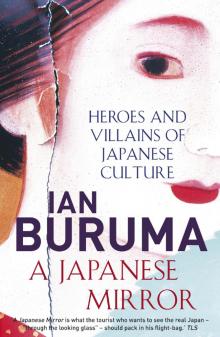 A Japanese Mirror
A Japanese Mirror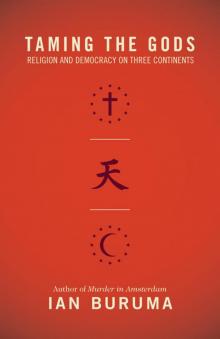 Taming the Gods
Taming the Gods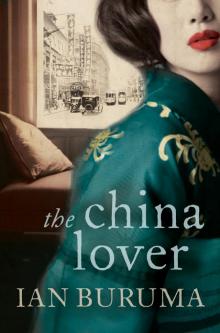 The China Lover
The China Lover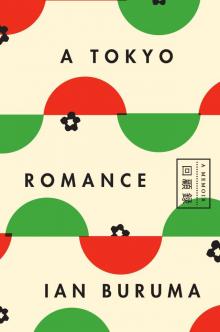 A Tokyo Romance
A Tokyo Romance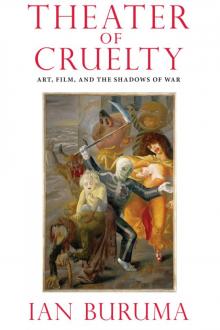 Theater of Cruelty
Theater of Cruelty Year Zero
Year Zero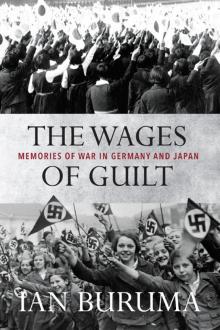 The Wages of Guilt
The Wages of Guilt Murder in Amsterdam
Murder in Amsterdam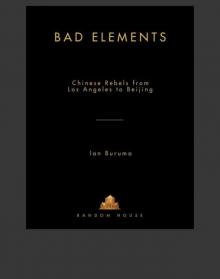 Bad Elements
Bad Elements Their Promised Land
Their Promised Land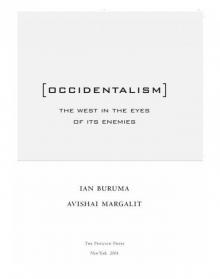 Occidentalism
Occidentalism Anglomania
Anglomania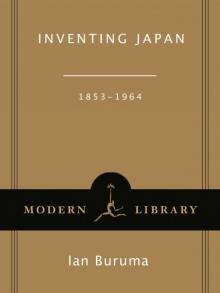 Inventing Japan: 1853-1964 (Modern Library Chronicles)
Inventing Japan: 1853-1964 (Modern Library Chronicles) The Missionary and the Libertine
The Missionary and the Libertine